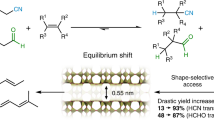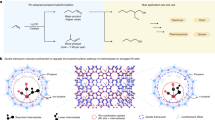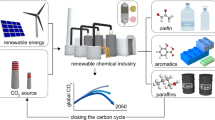Abstract
The Baeyer–Villiger oxidation, first reported more than 100 years ago1, has evolved into a versatile reaction widely used2 to convert ketones—readily available building blocks in organic chemistry—into more complex and valuable esters and lactones. Catalytic versions of the Baeyer–Villiger oxidation are particularly attractive for practical applications, because catalytic transformations simplify processing conditions while minimizing reactant use as well as waste production. Further benefits are expected from replacing peracids, the traditionally used oxidant, by cheaper and less polluting hydrogen peroxide3. Dissolved platinum complexes4 and solid acids, such as zeolites5,6 or sulphonated resins7, efficiently activate ketone oxidation by hydrogen peroxide. But these catalysts lack sufficient selectivity for the desired product if the starting material contains functional groups other than the ketone group; they perform especially poorly in the presence of carbon–carbon double bonds. Here we show that upon incorporation of 1.6 weight per cent tin into its framework, zeolite beta acts as an efficient and stable heterogeneous catalyst for the Baeyer–Villiger oxidation of saturated as well as unsaturated ketones by hydrogen peroxide, with the desired lactones forming more than 98% of the reaction products. We ascribe this high selectivity to direct activation of the ketone group, whereas other catalysts first activate hydrogen peroxide, which can then interact with the ketone group as well as other functional groups.
This is a preview of subscription content, access via your institution
Access options
Subscribe to this journal
Receive 51 print issues and online access
$199.00 per year
only $3.90 per issue
Buy this article
- Purchase on Springer Link
- Instant access to full article PDF
Prices may be subject to local taxes which are calculated during checkout

Similar content being viewed by others
References
Baeyer, A. & Villiger, V. Einwirkung des Caro’schen Reagens auf Ketone. Chem. Ber. 32, 3625–3633 (1899).
Renz, M. & Meunier, B. 100 years of Baeyer–Villiger oxidations. Eur. J. Org. Chem. 737–750 (1999).
Arends, I. W. C. E., Sheldon, R. A., Wallau, M. & Schuchardt, U. Oxidative transformations of organic compounds mediated by redox molecular sieves. Angew. Chem. Int. Edn Engl. 36, 1145–1163 (1997).
Strukul, G. Transition metal catalysis in the Baeyer–Villiger oxidation of ketones. Angew. Chem. Int. Edn Engl. 37, 1198–1209 (1998).
Fischer, J. & Hölderich, W. F. Baeyer-Villiger-oxidation of cyclopentanone with aqueous hydrogen peroxide by acid heterogeneous catalysis. Appl. Catal. A 180, 435–443 (1999).
Chang, C. D. & Hellring, S. D. Production of lactones and omega-hydroxycarboxylic acids. US Patent No. 4870192 (1996).
Hoelderich, W., Fischer, J., Schindler, G. -P. & Arntz, D. Preparation of lactones by Baeyer–Villiger oxidation of cyclic ketones. German Patent DE 19745442 (1999).
Jacobson, S. E., Tang, R. & Mares, F. Oxidation of cyclic ketones by hydrogen peroxide catalysed by group 6 metal peroxo complexes. J. Chem. Soc. Chem. Commun. 888–889 (1978).
Herrmann, W. A., Fischer, R. W. & Correia, J. D. G. Multiple bonds between main-group elements and transition metals. Part 133. Methyltrioxorhenium as a catalyst of the Baeyer–Villiger oxidation. J. Mol. Catal. 94, 213–223 (1994).
Gavagnin, R., Cataldo, M., Pinna, F. & Strukul, G. Diphosphine-palladium and -platinum complexes as catalysts for the Baeyer–Villiger oxidation of ketones: effect of the diphosphine, oxidation of acyclic ketones, and mechanistic studies. Organometallics 17, 661–667 (1998).
Palazzi, C., Pinna, F. & Strukul, G. Polymer-anchored platinum complexes as catalysts for the Baeyer–Villiger oxidation of ketones: preparation and catalytic properties. J. Mol. Catal. A 151, 245–252 (2000).
Bhaumik, A., Kumar, P. & Kumar, R. Baeyer–Villiger rearrangement catalysed by titanium silicate molecular sieve (TS-1)/H2O2 system. Catal. Lett. 40, 47–50 (1996).
Herrmann, W. A. Essays on organometallic chemistry, VII. Laboratory curiosities of yesterday, catalysts of tomorrow: organometallic oxides. J. Organomet. Chem. 500, 149–150 (1995).
Frisone, M. D. T., Pinna, F. & Strukul, G. Baeyer–Villiger oxidation of cyclic ketones with hydrogen peroxide catalyzed by cationic complexes of platinum(II): selectivity properties and mechanistic studies. Organometallics 12, 148–156 (1993).
Shambayati, S. & Schreiber, S. L. in Comprehensive Organic Synthesis Vol. 1 (eds Trost, B. M. & Fleming, I.) 283–324 (Pergamon, Oxford, 1991).
Camblor, M. A., Corma, A., Martínez, A. & Pérez-Pariente, J. Synthesis of a titaniumsilicoaluminate isomorphous to zeolite beta and its application as a catalyst for the selective oxidation of large organic molecules. J. Chem. Soc. Chem. Commun. 589–590 (1992).
Sen, T., Chatterjec, M. & Sivasanker, S. Novel large-pore vanadium alumino- and borosilicates with BEA structure. J. Chem. Soc. Chem. Commun. 207–208 (1995).
Huang, H. -H., Lu, M. -C. & Chen, J. -N. Catalytic decomposition of hydrogen peroxide and 2-chlorophenol with iron oxides. Wat. Res. 35, 2291–2299 (2001).
Valencia, S. & Corma, A. Stannosilicate molecular sieves. US Patent No. 5968473A (1999).
Kelly, D. R., Wan, P. W. H. & Tang, J. Biotechnology Vol. 8a Ch. 11, 535–587 (Wiley-VCH, Weinheim, 1998).
Acknowledgements
We thank CICYT and UOP for financial support.
Author information
Authors and Affiliations
Corresponding author
Supplementary information
"in-situ" IR experiments
Lewis acid-carbonyl adducts are well known and documented in literature. They have been found by X ray crystallography and in theoretical studies and observed by NMR and IR spectroscopy.
In the case of Sn-beta, in the IR spectrum a shift of 48 cm-1 of the carbonyl signal towards lower wavenumbers occurred, indicating the formation of an adduct between the carbonyl oxygen and the Sn incorporated in the framework of the zeolite (Figure 1a). With Si-beta or Si-beta impregnated with Sn no displacement of the carbonyl signal was obtained (Figure 1b). This clearly demonstrated that the Sn incorporated into the zeolite framework was the coordinating species and the catalytically active center.

Figure 1
(GIF 5 KB)
"in-situ" IR spectra of the adsorption of cyclohexanone in Sn-Beta (a) and Si-Beta (b).
-
1.
Shambayati, S., Crowe, W. E. & Schreiber, S. L. Angew. Chem. Int. Ed. Engl. 29, 256 - 272 (1990).
-
2.
a) Branchadell, V., & Oliva, A. J. Am. Chem. Soc. 114, 4357 - 4364 (1992). b) Nelson, D. J. J. Org. Chem. 51, 3185 - 3186 (1986).
-
3.
a) Childs, R. F., Mulholland, D. L. & Nixon, A. Can. J. Chem. 60, 801 - 808 (1982). b) Hartman, J. S., Stilbs, P. & Forsén, S. Tetrahedron Lett., 3497 - 3500 (1975).
-
4.
a) Dabrowski, J. & Katcka, M. J. Mol. Struct. 12, 179 - 183 (1972). b) Filippini, F. & Susz, B.-P. Helv. Chim. Acta 54, 835 - 845 (1971).
Oxidation of O-18 labelled 2-methylcyclohexanone
When von Doering and Dorfman clarified the mechanism of the Baeyer-Villiger reaction, they started with three hypotheses (rearrangement via the Criegee intermediate, via the dioxirane or via a carbonyl oxide; for a detailed discussion see ref.). The problem was solved well by the means of a labelling experiment. This technique should also be applied in the case of the H2O2/Sn-Beta oxidation system. As substrate 2-methylcyclohexanone was chosen because the corresponding product, e-methyl-e-caprolactone desintigrates in the mass spectrometer predominantly into a fragment with only the carbonyl oxygen (eq. 1). In the case that the substrate is not labelled to 100%, the ratio calculated from the mass peaks 128 and 130 gave the labelling content in the whole molecule which can be compared with the labelling content in the carbonyl position. The latter is obtained from the ratio of the mass peaks 84 and 86.

mass with 16O/16O = 128 || mass with 16O = 84
mass with 18O/16O = 130 || mass with 18O = 86
The 18O labeled 2-methylcyclohexanone was obtained by stirring the ketone with labeled water (18O content 96%) in a bi-phasic system for 2 h. The 18O content in the labeled product was 89%

To prove the reliability of the test reaction, the Baeyer-Villiger reaction was first carried out with meta-chloroperbenzoic acid (mCPBA, eq. 3). For this oxidant the mechanism

is well established and the labeled oxygen should only be detected in the carbonyl position. And indeed, the ratios of the mass peaks 84/86 and 128/130 were identical within the experimental error limit with 0.170 : 0.830 and 0.179 : 0.821, respectively. However, it must be stated that the content of labeled oxygen in the molecule dropped from 89% in the 2-methylcyclohexanone directly after the preparation to 82% in the lactone product. Taking the method of preparation of the labeled substrate into account, it was clear that any water molecule (unlabeled) present in the reaction solution would lower the labeling content in the substrate molecule. This was confirmed by the 18O content in the recovered substrate after the oxidation reaction. Here the value dropped even more, namely from 89% to 42%. Consequently, the reaction was repeated in well dried solvent and with mCPBA stored over molecular sieves 3 Å and in the presence of molecular sieves 3Å. Under these conditions 89% of labeled oxygen were found in the lactone product and all labeled oxygen detected in the carbonyl position.
In summary, with the peracid oxidation it was demonstrated clearly that the Baeyer-Villiger reaction with 18O labeled 2-methylcyclohexanone was a good test reaction to establish the reaction mechanism.
The oxidation of labeled 2-methylcyclohexanone with hydrogen peroxide catalyzed by Sn-beta (eq. 4) could not be carried out under anhydrous conditions, first of all, because water (unlabeled) is built as by-product.

Secondly, molecular sieves cannot be employed as drying agent because hydrogen peroxide would be adsorbed as well as water and, additionally, the hydrogen peroxide would be decomposed due to the acidity of the zeolite. Therefore, only the solvent was pre-dried with molecular sieves and the reaction was carried out in the presence of MgSO4 and with a short reaction time (30 min). The total amount of labelled oxygen in the lactone product dropped to 70%, but in the carbonyl position were also found exactly 70% of labelled oxygen. That demonstrated unambiguously that the reaction mechanism of the Baeyer-Villiger oxidation with hydrogen peroxide catalysed by Sn-beta proceeds via a Criegee adduct of the hydrogen peroxide with the ketone substrate in the same manner as with peracids (Scheme 1). Due to the not completely anhydrous reaction conditions the amount of labeled oxygen in the recovered ketone had dropped to 57%.

Scheme 1
Reaction mechanism of the Baeyer-Villiger oxidation with hydrogen peroxide catalyzed by Sn-beta zeolite confirmed with a 18O labeled substrate (the role of the tin was neglectet).
-
5.
Renz, M. & Meunier, B. Eur. J. Org. Chem., 737-750 (1999).
119Sn MAS NMR
Experimental
The 119Sn magic angle spinning (MAS) nuclear magnetic resonance (NMR) spectra were recorded with an spectrometer Varian VXR-S 400 WB at a frequency of 149.0 MHz, using a 5 mm high speed Doty probe. Samples were packed into silicon nitride rotors and span at a rate of 8 KHz. The spectra were recorded using pulses of 3.5 ms to flip the magnetisation an angle of 60º, and recycle delays of 50 s. Chemical shifts are referred to tetramethyltin using SnO2 as a secondary reference (-604 ppm). After drying, the sample was again submitted to 119Sn MAS NMR.
Results
119Sn possesses a nuclear spin of ½ and a natural abundance of 8.6%. Because of this and the low tin content 119Sn enriched reactants were used to prepare the samples in order to detect an NMR signal.
Figure 2 shows the 119Sn MAS NMR spectra of SnO2 supported on zeolite Beta (SnO2/Beta, Figure 2b), and zeolite Sn-Beta with a similar tin content (1.6%) in a hydrated (Figure 2a) and a dehydrated form (Figure 2c). The spectrum of the sample prepared by impregnation consists of a peak at –605 ppm characteristic of octahedrally coordinated Sn in SnO2, which is absent in zeolite Sn-Beta. The spectrum of hydrated zeolite Sn-Beta is formed by two peaks at –688 ppm and –700 ppm and a broader resonance at –740 ppm. Signals at chemical shifts between –685 ppm and –706 ppm have been previously reported for tin-silicalites with the MFI structure,,, and at ca. –740 ppm for the MEL structure.7, Also, resonances at ca. –677 ppm and ca. –710 ppm are observed in tin-containing mesoporous molecular sieves of MCM-41 type.
Non spinning 119Sn NMR spectra have been recorded for hydrated and dehydrated Sn-MFI molecular sieves.9 The hydrated form gives a main resonance at –687 ppm with a shoulder at –573 ppm. After dehydration, the peak at –687 ppm remained unchanged, while the peak at –573 ppm was shifted to –439 ppm. This latter resonance has been ascribed to tetrahedral Sn, which had become octahedral by coordinating water molecules. Therefore, in our case the peak at –444 ppm in dehydrated Sn-Beta can be attributed to framework tetrahedral Sn (Figure 2c). The peaks present in the spectrum of the hydrated Sn-Beta zeolite can be assigned to framework Sn with two additional water molecules as ligands, acquiring octahedral coordination (Figure 2a).

Figure 2
(GIF 31.9 KB)
Characterization of Sn-Beta zeolite
The X-Ray diffraction pattern of calcined Sn containing zeolite Beta (Figure 3) clearly shows the high crystallinity of the material and indicates that incorporation of Sn does not cause any loss of crystallinity (as compared to the all silica Beta). No peaks due to SnO2 or other impurities are observed in the XRD pattern.

Figure 3
(GIF 4.32 KB)
X-Ray diffraction patterns of calcined Sn-Beta and all silica Beta zeolites.
Rights and permissions
About this article
Cite this article
Corma, A., Nemeth, L., Renz, M. et al. Sn-zeolite beta as a heterogeneous chemoselective catalyst for Baeyer–Villiger oxidations. Nature 412, 423–425 (2001). https://doi.org/10.1038/35086546
Received:
Accepted:
Issue Date:
DOI: https://doi.org/10.1038/35086546
This article is cited by
-
CuO impregnated SBA-15; an efficient catalyst for B–V oxidation of cyclohexanone to caprolactone
Journal of Porous Materials (2024)
-
Baeyer–Villiger oxidation of cyclic ketones with H2O2 over mesoporous Sn- and Zr-BEA zeolites
Applied Nanoscience (2023)
-
Synthesis of Lewis Acid Sites in SBA-15 and Amorphous Silica Using Vapor Phase Infiltration of Zr and Sn
Catalysis Letters (2023)
-
Effect of Sn and Zr Content in ZrAl- and SnAl-BEA Hierarchical Zeolites on Their Acidic and Catalytic Properties in the Process of Cyclohexanone Oxidation with Hydrogen Peroxide
Theoretical and Experimental Chemistry (2023)
-
Influence of Sn Content in Sn-β on Selective Production of Methyl Lactate from Glucose
Catalysis Letters (2023)
Comments
By submitting a comment you agree to abide by our Terms and Community Guidelines. If you find something abusive or that does not comply with our terms or guidelines please flag it as inappropriate.



